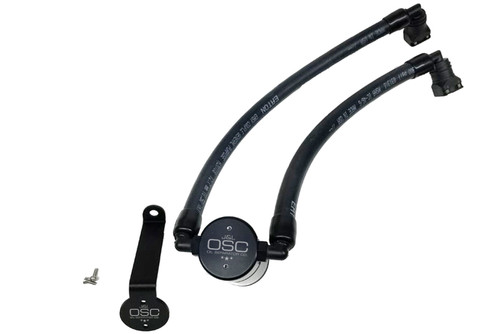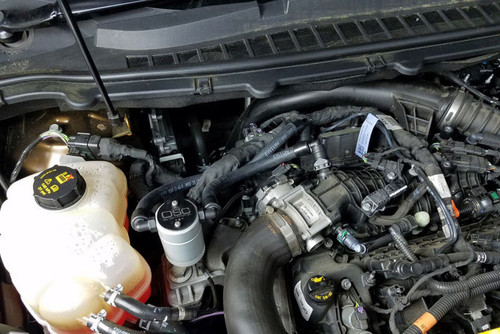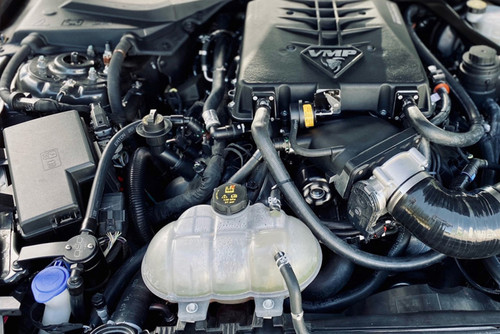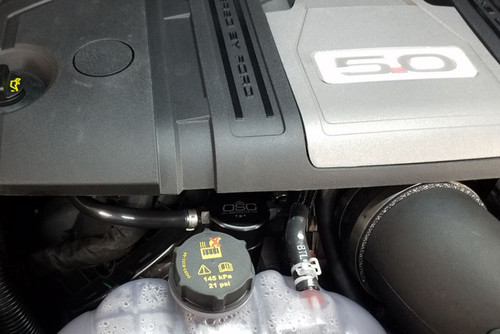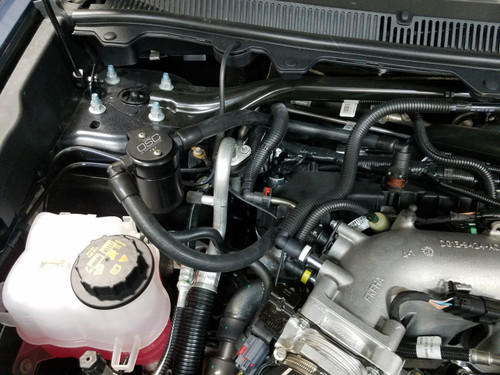During the process of venting crankcase pressure back through your intake track, large amounts of oil, in the form of vapors can gather/accumulate in your intake tube, intake manifold runners and even dilute your gas, lowering its octane level. This happens on all engines and is even worse with forced inducted vehicles (supercharged and turbocharged) as crankcase pressures are increased. To combat this, we have developed an oil separator of our own design. Milled from solid billet aluminum this is a rock-solid piece. It has a knurled tank base for easy removal to drain the spent oil and an O-ring seal to prevent any leaks.
Filtering consists of a fine mesh stainless steel screen that traps fine oil vapors and releases them once heavy enough to fall. They then pass through a 1/2" thick 1/16th" aluminum honeycomb filter where they grow every larger and then fall into the bottom. By the time the oil gets through the filter it's too heavy to be passed on into the intake. The tank holds 3 oz of fluid, while that may not sound like a lot, you shouldn*t see that much oil in your PCV system. Drain it every 2000-3000 miles and you will never come close to filling it.
J&L Oil Separator 3.0 Passenger Side, Black Anodized (2015-2020 Ford Edge Sport/ST; 2016-2019 Lincoln MKX 2.7L EcoBoost V6)
Fitment:
FordEdgeSport2015
FordEdgeSport2016
FordEdgeSport2017
FordEdgeSport2018
FordEdgeST2019
FordEdgeST2020
FordEdgeST2021
FordEdgeST2022
LincolnMKXBlack Label2016
LincolnMKXBlack Label2017
LincolnMKXBlack Label2018
LincolnMKXPremiere2016
LincolnMKXPremiere2017
LincolnMKXPremiere2018
LincolnMKXReserve2016
LincolnMKXReserve2017
LincolnMKXReserve2018
LincolnMKXSelect2016
LincolnMKXSelect2017
LincolnMKXSelect2018
LincolnNautilusBlack Label2019
LincolnNautilusBlack Label2020
LincolnNautilusBlack Label2021
LincolnNautilusBlack Label2022
LincolnNautilusReserve2019
LincolnNautilusReserve2020
LincolnNautilusReserve2021
LincolnNautilusReserve2022
LincolnNautilusSelect2019
J&L
J&L 15-19 Ford Edge Sport/ST Passenger Side Oil Separator 3.0 - Black Anodized
$169.00
- SKU:
- 3031P-B
- UPC:
- 887753721631
Related Products
An relatable roduct

